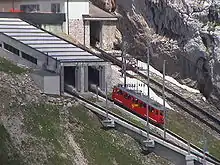Pilatus Railway
The Pilatus Railway (German: Pilatusbahn, PB) is a mountain railway in Switzerland and is the steepest rack railway in the world, with a maximum gradient of 48% and an average gradient of 35%. The line runs from Alpnachstad, on Lake Alpnach, to a terminus near the Esel summit of Pilatus at an elevation of 2,073 m (6,801 ft), which makes it the highest railway in the canton of Obwalden and the second highest in Central Switzerland after the Furka line. At Alpnachstad, the Pilatus Railway connects with steamers on Lake Lucerne and with trains on the Brünigbahn line of Zentralbahn.[1]
| Pilatus Railway | ||||||||||||||||||||||||||||||||||||||||||||||||||||||||||||||||||||||||||||||||||||||||||||||||||||||||||||||||||||||
|---|---|---|---|---|---|---|---|---|---|---|---|---|---|---|---|---|---|---|---|---|---|---|---|---|---|---|---|---|---|---|---|---|---|---|---|---|---|---|---|---|---|---|---|---|---|---|---|---|---|---|---|---|---|---|---|---|---|---|---|---|---|---|---|---|---|---|---|---|---|---|---|---|---|---|---|---|---|---|---|---|---|---|---|---|---|---|---|---|---|---|---|---|---|---|---|---|---|---|---|---|---|---|---|---|---|---|---|---|---|---|---|---|---|---|---|---|---|---|
 Pilatus Railway tracks are laid without ballast. | ||||||||||||||||||||||||||||||||||||||||||||||||||||||||||||||||||||||||||||||||||||||||||||||||||||||||||||||||||||||
| Overview | ||||||||||||||||||||||||||||||||||||||||||||||||||||||||||||||||||||||||||||||||||||||||||||||||||||||||||||||||||||||
| Native name | Pilatusbahn | |||||||||||||||||||||||||||||||||||||||||||||||||||||||||||||||||||||||||||||||||||||||||||||||||||||||||||||||||||||
| Status | Operational | |||||||||||||||||||||||||||||||||||||||||||||||||||||||||||||||||||||||||||||||||||||||||||||||||||||||||||||||||||||
| Locale | Obwalden, Switzerland | |||||||||||||||||||||||||||||||||||||||||||||||||||||||||||||||||||||||||||||||||||||||||||||||||||||||||||||||||||||
| Termini | Alpnachstad Pilatus Kulm | |||||||||||||||||||||||||||||||||||||||||||||||||||||||||||||||||||||||||||||||||||||||||||||||||||||||||||||||||||||
| Stations | 5 | |||||||||||||||||||||||||||||||||||||||||||||||||||||||||||||||||||||||||||||||||||||||||||||||||||||||||||||||||||||
| Service | ||||||||||||||||||||||||||||||||||||||||||||||||||||||||||||||||||||||||||||||||||||||||||||||||||||||||||||||||||||||
| Services | 1 | |||||||||||||||||||||||||||||||||||||||||||||||||||||||||||||||||||||||||||||||||||||||||||||||||||||||||||||||||||||
| History | ||||||||||||||||||||||||||||||||||||||||||||||||||||||||||||||||||||||||||||||||||||||||||||||||||||||||||||||||||||||
| Opened | 4 June 1889 (Steam), reopened 15 May 1937 | |||||||||||||||||||||||||||||||||||||||||||||||||||||||||||||||||||||||||||||||||||||||||||||||||||||||||||||||||||||
| Technical | ||||||||||||||||||||||||||||||||||||||||||||||||||||||||||||||||||||||||||||||||||||||||||||||||||||||||||||||||||||||
| Line length | 4.6 km (2.86 mi) | |||||||||||||||||||||||||||||||||||||||||||||||||||||||||||||||||||||||||||||||||||||||||||||||||||||||||||||||||||||
| Rack system | Locher | |||||||||||||||||||||||||||||||||||||||||||||||||||||||||||||||||||||||||||||||||||||||||||||||||||||||||||||||||||||
| Track gauge | 800 mm (2 ft 7 1⁄2 in) | |||||||||||||||||||||||||||||||||||||||||||||||||||||||||||||||||||||||||||||||||||||||||||||||||||||||||||||||||||||
| Electrification | 1550 V, DC overhead line | |||||||||||||||||||||||||||||||||||||||||||||||||||||||||||||||||||||||||||||||||||||||||||||||||||||||||||||||||||||
| Operating speed | 9 km/h (5.6 mph) downhill, about 10 km/h (6.2 mph) uphill. | |||||||||||||||||||||||||||||||||||||||||||||||||||||||||||||||||||||||||||||||||||||||||||||||||||||||||||||||||||||
| Highest elevation | 2,073 m (6,801 ft) | |||||||||||||||||||||||||||||||||||||||||||||||||||||||||||||||||||||||||||||||||||||||||||||||||||||||||||||||||||||
| Maximum incline | 48 % | |||||||||||||||||||||||||||||||||||||||||||||||||||||||||||||||||||||||||||||||||||||||||||||||||||||||||||||||||||||
| ||||||||||||||||||||||||||||||||||||||||||||||||||||||||||||||||||||||||||||||||||||||||||||||||||||||||||||||||||||||
History
The first project to build the line was proposed in 1873,[2] suggesting a 1,435 mm (4 ft 8 1⁄2 in) standard gauge and 25% maximal gradient. It was concluded that the project was not economically viable. Eduard Locher, an engineer with great practical experience, then proposed an alternative project with the maximum grade increased to 48%, cutting the distance in half. Conventional systems at the time could not negotiate such gradients because the cogwheel that is pressed to the rack from above may, under higher gradients, jump out of engagement with the rack, eliminating the train's driving and braking power. Instead, Locher placed a horizontal double rack between the two rails with the rack teeth facing each side. This was engaged by two flanged cogwheels mounted on vertical shafts underneath the car.
This design eliminated the possibility of the cogwheels climbing out of the rack, and prevented the car from toppling over, even under severe crosswinds common in the area. The system was also capable of guiding the car without the need for flanges on the wheels. Indeed, the first cars on Pilatus had no flanges on running wheels, but they were later added to allow cars to be moved through tracks without rack rails during maintenance. The line was opened using steam traction on 4 June 1889, and was electrified on 15 May 1937, using an overhead electric supply of 1550 V DC.
The government provided no subsidy for the construction of the line. Instead, Locher established his own company "Locher Systems" to build the railway. The railway was built entirely with private capital and has remained financially viable throughout its life.
The Pilatus Railway was named a Historic Mechanical Engineering Landmark by the American Society of Mechanical Engineers in 2001.[3][4]
Gallery
 Share of the Pilatus Railway Company, issued 1. July 1888; founder's share
Share of the Pilatus Railway Company, issued 1. July 1888; founder's share The train ready to leave, 4 June 1889
The train ready to leave, 4 June 1889 Pilatus Railway Time Table from 1905
Pilatus Railway Time Table from 1905 A railcar at the summit station
A railcar at the summit station Alpnachstad station; note the inclination of the platform behind the building
Alpnachstad station; note the inclination of the platform behind the building

 Pilatus Railway Rotary Switch
Pilatus Railway Rotary Switch The two row transfer table in Pilatus Railway, one edge also serving as a passenger platform
The two row transfer table in Pilatus Railway, one edge also serving as a passenger platform
Operation
The line is 4.6 km (2.86 mi) long, climbs a vertical distance of 1,629 m (5,344 ft), and is of 800 mm (2 ft 7 1⁄2 in) gauge. Because of the rack-system, there are no conventional points or switches on the line, only rotary switches (see photograph) and traversers. All rails are laid on solid rock, securing rails by high-strength iron ties attached to the rock, without using any ballast.
The line still uses original rack rails that are now over 100 years old. While they have worn down, it was discovered that this can be fixed by simply turning the rails over, providing a new wearing surface that would be sufficient for the next century as well. The cars' electric motors are used as generators to brake the car during descent, but this electricity is not reused — it is just dissipated as heat through resistance grids. Originally, the steam engines were used as compressors to provide dynamic braking, since the use of friction brakes alone is not practical on such steep slopes.
The line is operated seasonally: May to October. The cable-car, which approaches from the other side, runs all year except for a short maintenance period.
References
- "A Wonderful Railway". The Register. Adelaide: National Library of Australia. 2 March 1920. p. 5. Retrieved 13 February 2013.
- "Archived copy" (PDF). Archived from the original (PDF) on 7 September 2006. Retrieved 20 July 2009.CS1 maint: archived copy as title (link)
- "Pilatusbahn (1882)". Landmarks. American Society of Mechanical Engineers. Retrieved 18 January 2009.
- "Pilatusbahn" (PDF). Pilatusbahn brochure. ASME. Archived from the original (PDF) on 16 August 2009. Retrieved 18 January 2009.
Sources
- Book Tramways and Light Railways of Switzerland and Austria, ISBN 0-900433-96-5, by R.J.Buckley, published by the Light Rail Transit Association, 1984.
External links
 Media related to Pilatusbahn at Wikimedia Commons
Media related to Pilatusbahn at Wikimedia Commons- Pilatus Railway web site
- Scientific American 8/13/1904; The Mount Pilatus Railway, Switzerland
